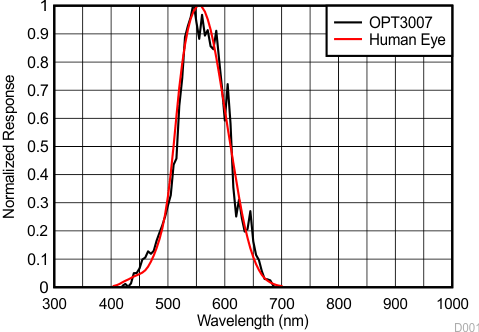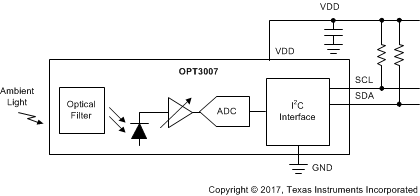SBOS864 August 2017 OPT3007
PRODUCTION DATA.
- 1 Features
- 2 Applications
- 3 Description
- 4 Revision History
- 5 Pin Configuration and Functions
- 6 Specifications
-
7 Detailed Description
- 7.1 Overview
- 7.2 Functional Block Diagram
- 7.3 Feature Description
- 7.4 Device Functional Modes
- 7.5 Programming
- 7.6
Register Maps
- 7.6.1
Internal Registers
- 7.6.1.1
Register Descriptions
- 7.6.1.1.1 Result Register (Offset = 00h)
- 7.6.1.1.2 Configuration Register (Offset = 01h) [Reset = C810h]
- 7.6.1.1.3 Low-Limit Register (Offset = 02h) [Reset = C0000h]
- 7.6.1.1.4 High-Limit Register (Offset = 03h) [Reset = BFFFh]
- 7.6.1.1.5 Manufacturer ID Register (Offset = 7Eh) [Reset = 5449h]
- 7.6.1.1.6 Device ID Register (Offset = 7Fh) [Reset = 3001h]
- 7.6.1.1
Register Descriptions
- 7.6.1
Internal Registers
- 8 Application and Implementation
- 9 Power-Supply Recommendations
- 10Layout
- 11Device and Documentation Support
- 12Mechanical, Packaging, and Orderable Information
Package Options
Mechanical Data (Package|Pins)
- YMF|6
Thermal pad, mechanical data (Package|Pins)
Orderable Information
1 Features
- Precision Optical Filtering to Match Human Eye:
- Rejects > 99% (Typical) of IR
- Automatic Full-Scale Setting Feature
- Measurements: 0.01 Lux to 83k Lux
- 23-Bit Effective Dynamic Range With
Automatic Gain Ranging - 12 Binary-Weighted Full-Scale Range Settings:
< 0.2% (Typical) Matching Between Ranges - Low Operating Current: 1.8 µA (Typical)
- Operating Temperature Range: –40°C to +85°C
- Wide Power-Supply Range: 1.6 V to 3.6 V
- Fixed I2C Address
- 5.5-V Tolerant I/O
- Fixed I2C Address
- Small-Form Factor:
- 0.856-mm × 0.946-mm × 0.226-mm PicoStar™ Package
- OPT3007 is Smaller Version of OPT3001
2 Applications
- Smart Watches
- Wearable Electronics
- Health Fitness Bands
- Display Backlight Controls
- Lighting Control Systems
- Tablet and Notebook Computers
- Cameras
Spectral Response: The OPT3007 and Human Eye

3 Description
The OPT3007 is a single-chip lux meter, measuring the intensity of visible light as seen by the human eye. The OPT3007 is available in an ultra-small PicoStar package, so the device fits into tiny spaces. The OPT3007 has a fixed addressing scheme which enables the device to operate with only four pins connected. This enables the PCB designer to create a bigger opening to the active sensor area.
The precision spectral response of the sensor tightly matches the photopic response of the human eye. With strong infrared (IR) rejection, the OPT3007 measures the intensity of light as seen by the human eye, regardless of the light source. The IR rejection also aids in maintaining high accuracy when design requires mounting the sensor under dark glass. The OPT3007, often in conjunction with backlight ICs or lighting control systems, creates light-based experiences for humans, and is a replacement for photodiodes, photoresistors, or lower-performing ambient light sensors.
Measurements can be made from 0.01 lux up to 83k lux without manually selecting full-scale ranges by using the built-in, full-scale setting feature. This capability allows light measurement over a 23-bit effective dynamic range.
The digital operation is flexible for system integration. Measurements can be either continuous or single-shot. The digital output is reported over an I2C- and SMBus-compatible, two-wire serial interface.
Device Information(1)
| PART NUMBER | PACKAGE | BODY SIZE (NOM) |
|---|---|---|
| OPT3007 | PicoStar (6) | 0.856 mm × 0.946 mm × 0.226 mm |
- For all available packages, see the package option addendum at the end of the data sheet.
Block Diagram

4 Revision History
| DATE | REVISION | NOTES |
|---|---|---|
| August 2017 | * | Initial release. |